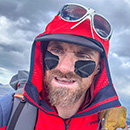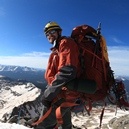i kinda would be in the camp that steepness is less than you think. I'm hoping that all my non snow climbing helps with me feeling comfortable in most couloirs this year. being confident and comfortable in a climb is essential. not the funnest day to have a partner freeze up in fear half way into a climb.
if you feel you need appropriate safety gear, bring it! just remember, gear = weight, weight slows you down, the slower you go, the more time you're in a more dangerous place than level ground.
Couloir climbing questions
Forum rules
- This is a mountaineering forum, so please keep your posts on-topic. Posts do not all have to be related to the 14ers but should at least be mountaineering-related.
- Personal attacks and confrontational behavior will result in removal from the forum at the discretion of the administrators.
- Do not use this forum to advertise, sell photos or other products or promote a commercial website.
- Posts will be removed at the discretion of the site administrator or moderator(s), including: Troll posts, posts pushing political views or religious beliefs, and posts with the purpose of instigating conflict within the forum.
-
justiner

- Posts: 4689
- Joined: 8/28/2010
- 14ers: 3 1
- Trip Reports (37)
Re: Couloir climbing questions
Long May You Range! Purveyors of fine bespoke adventures
-
I Man

- Posts: 1027
- Joined: 7/18/2011
- 14ers: 58 49
- 13ers: 74 7
- Trip Reports (30)
Re: Couloir climbing questions
Dave B wrote:I think the approach anyone takes in learning these skills is going to be entirely dependent on risk acceptance.
You can touch the void, just don't fall into it.
I fly a starship across the universe divide....and when I reach the other side...I'll find a place to rest my spirit if I can. Perhaps I may become a Mountain Man again.
I fly a starship across the universe divide....and when I reach the other side...I'll find a place to rest my spirit if I can. Perhaps I may become a Mountain Man again.
-
MyFeetHurt

- Posts: 200
- Joined: 7/8/2007
- 14ers: 58
- Trip Reports (0)
Re: Couloir climbing questions
If you are digging pits to assess the snowpack, you are probably very experienced and climbing in a winter snowpack. Otherwise, leave the shovel at home and wait until the snowpack has fully consolidated. This transition is happening right now, and within a few weeks even the north aspects will be good to go, (generally speaking) or are already in good conditions in a few areas. As you gain experience you'll find that digging a pit in a consolidated snowpack is nearly impossible, and totally unnecessary.
When are you climbing, if you kick steps and your boot only goes in up to your toes or less, you may want to consider a rope and a second tool (assuming it is at all steep). You will have a hard time self arresting in these conditions, if you are lucky enough to get a pick in it will stop so abruptly you may not be able to hold on.
On the other side of the spectrum, if you kick in your feet and it goes in much past the top of your boot and the sun is out, you may be nearing the possibility of a wet slide. Same thing if your foot steps collapse under your weight in a slushy mess. Self arresting in this mess is hard as well, because your pick will not have much bite, but the slide is slow and sinks into the snow.
Any condition in between is usually pretty good, and I would expect to start on one condition and end up on the other as the climb progresses.
Leave the shovel at home. You would have to try hard to find whumpfs and shooting cracks in late April, though it's possible. Instead, stay away from fresh snow, rain, and unseasonably warm weather for the few days prior. These are more obvious and acceptable indicators starting around this time of year. Make no mistake though, this is still early season for couloirs if you don't know what you are doing.
When are you climbing, if you kick steps and your boot only goes in up to your toes or less, you may want to consider a rope and a second tool (assuming it is at all steep). You will have a hard time self arresting in these conditions, if you are lucky enough to get a pick in it will stop so abruptly you may not be able to hold on.
On the other side of the spectrum, if you kick in your feet and it goes in much past the top of your boot and the sun is out, you may be nearing the possibility of a wet slide. Same thing if your foot steps collapse under your weight in a slushy mess. Self arresting in this mess is hard as well, because your pick will not have much bite, but the slide is slow and sinks into the snow.
Any condition in between is usually pretty good, and I would expect to start on one condition and end up on the other as the climb progresses.
Leave the shovel at home. You would have to try hard to find whumpfs and shooting cracks in late April, though it's possible. Instead, stay away from fresh snow, rain, and unseasonably warm weather for the few days prior. These are more obvious and acceptable indicators starting around this time of year. Make no mistake though, this is still early season for couloirs if you don't know what you are doing.
Re: Couloir climbing questions
You offer good advice about evaluating wet slab instabilities but NEVER leave the shovel at home. If you travel in snow any time of year, beacon, probe, and shovel are a necessity (as well as knowledge of how to use them) so you can rescue a friend in an avalanche as well as many other circumstances that require a shovel. Do not hang out in snow in the mountains without a shovel! EVER! If I forget my beacon, probe, or shovel I go home and come back another day. Avalanche instabilities do not go away after mid May. People do die frequently during this time. ALWAYS bring a shovel and the rest of your avalanche recue gear when traveling on or near snow any time of year. Avalanche hazard is not just good to go after mid-May. Avalanche hazard can become a bit more predictable in the spring if you are paying attention, climb early and get off mountains and couloirs early but never stop thinking about avalanches. The snowpack is never fully consolidated, there are almost always important avalanche considerations, even in the spring.MyFeetHurt wrote:If you are digging pits to assess the snowpack, you are probably very experienced and climbing in a winter snowpack. Otherwise, leave the shovel at home and wait until the snowpack has fully consolidated. This transition is happening right now, and within a few weeks even the north aspects will be good to go, (generally speaking) or are already in good conditions in a few areas. As you gain experience you'll find that digging a pit in a consolidated snowpack is nearly impossible, and totally unnecessary.
When are you climbing, if you kick steps and your boot only goes in up to your toes or less, you may want to consider a rope and a second tool (assuming it is at all steep). You will have a hard time self arresting in these conditions, if you are lucky enough to get a pick in it will stop so abruptly you may not be able to hold on.
On the other side of the spectrum, if you kick in your feet and it goes in much past the top of your boot and the sun is out, you may be nearing the possibility of a wet slide. Same thing if your foot steps collapse under your weight in a slushy mess. Self arresting in this mess is hard as well, because your pick will not have much bite, but the slide is slow and sinks into the snow.
Any condition in between is usually pretty good, and I would expect to start on one condition and end up on the other as the climb progresses.
Leave the shovel at home. You would have to try hard to find whumpfs and shooting cracks in late April, though it's possible. Instead, stay away from fresh snow, rain, and unseasonably warm weather for the few days prior. These are more obvious and acceptable indicators starting around this time of year. Make no mistake though, this is still early season for couloirs if you don't know what you are doing.
"May your trails be crooked, winding, lonesome, dangerous, leading to the most amazing view. May your mountains rise into and above the clouds." Edward Abbey
...
http://www.zachtaylorsnowboarding.com" onclick="window.open(this.href);return false;
http://www.14ersnowboardproject.homestead.com" onclick="window.open(this.href);return false;
...
http://www.zachtaylorsnowboarding.com" onclick="window.open(this.href);return false;
http://www.14ersnowboardproject.homestead.com" onclick="window.open(this.href);return false;
-
Mike Shepherd

- Posts: 260
- Joined: 4/21/2014
- 14ers: 12
- 13ers: 5
- Trip Reports (3)
Re: Couloir climbing questions
I am hoping to feel more confident this year while climbing. In the past I have done some rock climbing, but had a bad experience that sort of spooked me. I was climbing in Tahquitz, a 5.6 4 pitch trad route, my buddy who was much more experienced placed the gear I just cleaned it. He climbed the last pitch over this slight bulge of rock and went to set up an anchor. I was left sitting on this ledge waiting to go up the last pitch as it started to get pretty late in the afternoon. Either because of the bulge or the wind or something we just could not hear each other at all. There was too much rope drag to get any sort of signal from tugging on the rope that he had established a spot to belay me. I kind of panicked on the ledge unsure if I was being belayed or not, and just went for the went for the last pitch for fear of climbing in the dark. Other than loosing a nut that once freed from the crack ended up sailing over my shoulder hundreds of feet below, I did just fine. I'm not sure why I panicked, I was pretty inexperienced and I think the fear of the unknown got me that day.justiner wrote: I'm hoping that all my non snow climbing helps with me feeling comfortable in most couloirs this year. being confident and comfortable in a climb is essential. not the funnest day to have a partner freeze up in fear half way into a climb.
Friends don't let friends wear microspikes
-
LadyClimber

- Posts: 102
- Joined: 8/12/2013
- 14ers: 6
- 13ers: 6
- Trip Reports (0)
Re: Couloir climbing questions
Mike, I've been climbing alpine routes for over 10 years now, and I still occasionally find myself feeling the same way you did on your multipitch climb. When it seems like it's taking my partner way too long, my mind starts spinning tails of him/her getting off route, falling, etc. So you aren't alone and I wouldn't let that experience spook you. The more long routes you climb with the same partner(s) the less often that feeling will happen, and you'll get your system down. That being said, learning to place you own gear will give you a boost of confidence too. Also taking the lead, when you're ready, will help you gain the perspective of what it's like to be the climber 150' above you partner trying to find a good anchor and wondering if you past it or need to keep going-it will help you be more patient and less concerned when you're the belayer.
-
GeorgiaTyler

- Posts: 343
- Joined: 2/17/2010
- 14ers: 22
- 13ers: 22
- Trip Reports (0)
Re: Couloir climbing questions
get the Colorado snow climbs book after your class. go out and have fun. Most of these routes are super moderate once you get in them, the couloirs always look steeper than they are. Go out on a bluebird day, early and climb until you feel uncomfortable.. my bet on 35-40 degree slope you won't feel uneasy at all. Couloir climbs are the best.
Climb up Pints down
-
Monster5

- Posts: 1775
- Joined: 8/7/2009
- 14ers: 58 34
- 13ers: 291 37
- Trip Reports (28)
Re: Couloir climbing questions
No love for the "mostly cloudy?" Snow generally stays firm, no lobster fry cookout, and no going blind via the deadly dripping sunscreen/foggy glasses epidemic. There are a few traitors among us willing to adopt the weird pacific NW style atrocity of shorts and mountaineering boots/gaiters. I tend to crop those freaks out of my pictures.
GeorgiaTyler wrote: Go out on a bluebird day
"The road to alpine climbing is pocked and poorly marked, ending at an unexpectedly closed gate 5 miles from the trailhead." - MP user Beckerich
-
CO Native

- Posts: 4877
- Joined: 7/26/2004
- 14ers: 58 2 15
- 13ers: 29
- Trip Reports (48)
Re: Couloir climbing questions
Which is why I like to wear a harness and attach my axe to it.MyFeetHurt wrote:When are you climbing, if you kick steps and your boot only goes in up to your toes or less, you may want to consider a rope and a second tool (assuming it is at all steep). You will have a hard time self arresting in these conditions, if you are lucky enough to get a pick in it will stop so abruptly you may not be able to hold on.
Remember what your knees are for.
http://www.hikingintherockies.com
http://www.hikingintherockies.com
-
Mike Shepherd

- Posts: 260
- Joined: 4/21/2014
- 14ers: 12
- 13ers: 5
- Trip Reports (3)
Re: Couloir climbing questions
That is good to hear. All I can do is wonder till I get up there at this point. Thanks to everyone for the replies. Also I had heard you should tip the guides when you are finished what is a decent percentage tip? The class is just me and the guide.GeorgiaTyler wrote: my bet on 35-40 degree slope you won't feel uneasy at all. Couloir climbs are the best.
Friends don't let friends wear microspikes
-
Boggy B

- Posts: 865
- Joined: 10/14/2009
- 14ers: 58 7
- 13ers: 781 76
- Trip Reports (50)
Re: Couloir climbing questions
Shush Ryan.
There's a climb-versus-ski consideration to be taken here, which will affect your timing and loadout. You're in the "climb" category, so hard snow means good time. Tis the season in different places at different times. W-SW-S-facing lines normally come in and go out fast. NW and SE lines stay for a bit longer. N-NE-E lines last the longest (into September a few years ago). Sangres melt first, then the rest of the state. Get on the route as early as you like; I usually shoot for "at the base of the line by first light" so I can at least see if it's in before getting on it. If only your points are going in and you wish you had a second tool, you're doing it right.
There's a climb-versus-ski consideration to be taken here, which will affect your timing and loadout. You're in the "climb" category, so hard snow means good time. Tis the season in different places at different times. W-SW-S-facing lines normally come in and go out fast. NW and SE lines stay for a bit longer. N-NE-E lines last the longest (into September a few years ago). Sangres melt first, then the rest of the state. Get on the route as early as you like; I usually shoot for "at the base of the line by first light" so I can at least see if it's in before getting on it. If only your points are going in and you wish you had a second tool, you're doing it right.
-
Monster5

- Posts: 1775
- Joined: 8/7/2009
- 14ers: 58 34
- 13ers: 291 37
- Trip Reports (28)
Re: Couloir climbing questions
Oh I'm sorry. Did the traitor say something?
OP - Throw the instructor a $20 or (better) buy him a good beer or something. Some sort of token acknowledgement that gives it more a sense of camaraderie than of a business transaction. Tipping has gotten out of hand on just about everything nowadays, particularly for non tip-based employees. (Cue forthcoming indignant rage...)Boggy B wrote:Opinions and yawners and junk
You do not have the required permissions to view the files attached to this post.
"The road to alpine climbing is pocked and poorly marked, ending at an unexpectedly closed gate 5 miles from the trailhead." - MP user Beckerich


